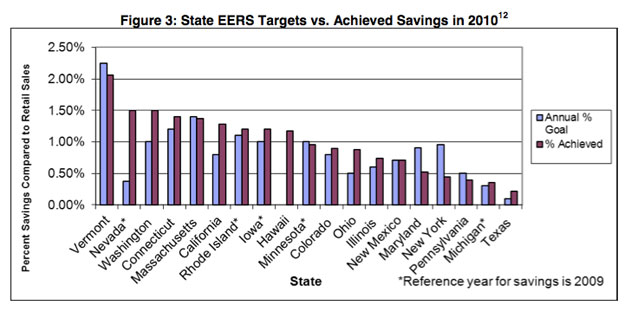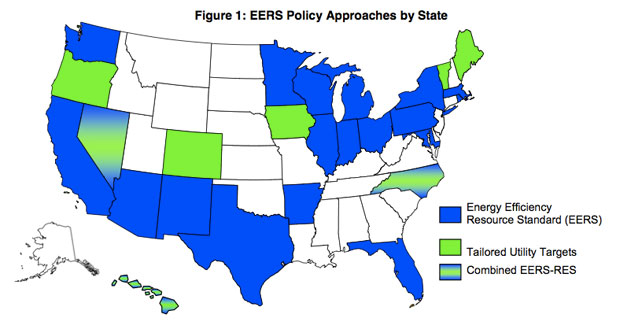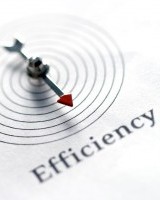Cross-posted from Climate Progress.
Since 2004, 26 states have put long-term energy efficiency resource standards (EERS) into place. Like renewable energy standards, these programs set long-term targets for demand reductions that power providers must meet — usually by helping end-use customers save energy.
A new report out from the American Council on Energy Efficiency Economy (ACEEE) looks at 19 of those programs [PDF] that have been in place for over two years. And guess what? Thus far, the programs are working.
According to ACEEE, “almost every state with an EERS is on track, meeting, or exceeding goals in 2010.”
To date, 13 states have achieved 100 percent of their targets, three states are at 90 percent of their targets, and only three others are below 80 percent.
A word of caution, however: These are still early days for many programs, so targets will get harder to meet as time goes on. ACEEE says some states may drop off, or wait until the final year of a program to make demand reductions:
While the figure above positively portrays states currently meeting goals, the hard work has yet to come. Targets in many states are still increasing and sustaining aggressive savings levels will be a challenge for states. In states where EERS policies are still ramping up and have low annual savings goals for 2010, such as Ohio, Illinois, and Michigan, meeting goals in the coming years will be challenging and deserves ongoing attention and analysis.
Another reason some states are falling below target levels in 2010 is that some EERS policies set long-term goals, which place emphasis on long-term, rather than annual achievements. Pennsylvania and Vermont, for example, set two- and three-year savings targets for 2011, respectively. Past experiences in Vermont and California have demonstrated that it is common for states to make a major push in the final year to make up for lower savings in prior years. This trend seems to be continuing in Pennsylvania, where savings in the first two quarters of its second program year far outpaced levels of its first.

It appears that in the states meeting their targets, consumers are seeing a benefit. Although this progress report doesn’t do a detailed cost-benefit analysis of every state program, it does highlight a few key experiences in leading states:
Available data thus far indicates that the benefits of efficiency programs driven by EERS policies have proven to substantially exceed administrator and customer costs.
- Hawaii Energy, the state’s third-party Public Benefits Fee Administrator, collects a percent of each electric utilities customer’s bill and is responsible for carrying out Hawaii’s energy-efficiency and conservation programs. Hawaii Energy achieved net customer energy savings of 113,159 megawatt-hours, meeting 97 percent and 81 percent of its residential and commercial targets, respectively. Over the lifetime of these rebated and installed measures, cost savings will yield a 546 percent return on Hawaii’s investment of $46.9 million ($17M/$29.9M Ratepayer/Customer Investment) (Hawaii Energy 2010).
- In Illinois, independent analysis of ComEd’s programs in its second program year found the benefit-cost ratio based on the Illinois Total Resource Cost (TRC) test to be 2.84 (Navigant Consulting 2010). Ameren Illinois met its goals in 2009 cost-effectively and its portfolio scored a 2.78 using a TRC test (Ameren Illinois Utilities 2010).
- In 2010, Efficiency Vermont saved 114 gigawatt-hours at a cost of 4.1 cents per kilowatt-hour (over the life of the measures). Efficiency Vermont spent $35.4 million on efficiency programs, participants spent $21.7 million, and the overall lifetime benefits equaled $136.1 million (Efficiency Vermont 2011).
- In Colorado, Xcel Energy reports that its electric demand-side management (DSM) programs had an overall benefit-cost ratio of 3.3 while the gas DSM programs had a benefit-cost ratio of about 1.6. Xcel Energy spent $54.7 million on electric DSM programs and $16.9 million on gas DSM programs last year. The company estimates that electric programs alone will result in $227 million in net economic benefits for customers over the lifetime of energy-efficiency measures installed due to its 2010 DSM programs. Gas DSM programs will result in about $15 million in net economic benefits (Xcel Energy 2010).
ACEEE has also been calling for a national energy efficiency target, which it says can save ratepayers more than $168 billion per year. But like with renewable energy, the action continues to happen at the state level for now, not nationally.





